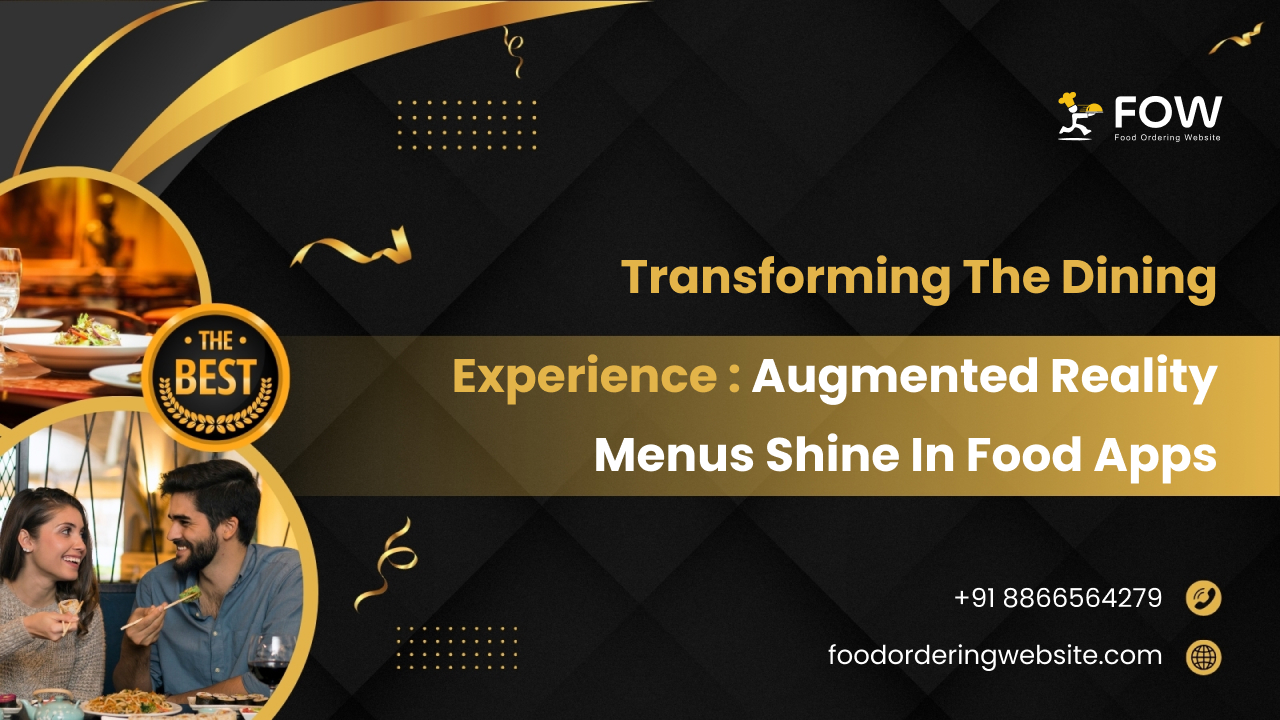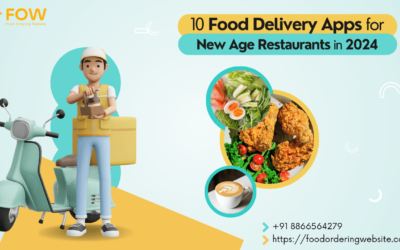This is because the introduction of Augmented Reality (AR) 3D Menu apps is taking a completely new shape in this area, which among well recognized and characterized by dynamism and high level of competitiveness; the restaurant industry. Apart from being technological gimmicks, those apps are more than capable of being true game-changing that will tip the balance in the growth and success of restaurants. In this fast-paced world, keeping pace with the change is imperative and AR menus provide a modern way of interacting with the consumers and making dining-out much more than mere eating. For that the best quality AR digital menu app development is important.
Global AR Market Growth:
The augmented reality market on a global estimate would amount to around 43.8% CAGR during the forecast year 2021-2028.
- 2. The Emergence of Augmented Reality in Culinary Sector
- 3. The Role Played by AR Menus in Reinventing Dining Experiences
- 4. Mobile AR Users:
- 5. Benefits of AR Digital Menu App Development in Driving Growth
- 6. Benefits of Implementing AR Foods Menu in Food Apps
- 7. Challenges and Considerations
- 8. Case Studies: Successful Implementations of E-Menus in App
- 9. Case Study 2: Domino’s Pizza
- 10. The Future of AR Menus in the Food Industry
- C. Potential Challenges on the Horizon
- 11. Recommendations for Restaurants and Food Apps
- 12. Conclusion
2. The Emergence of Augmented Reality in Culinary Sector
A. Brief Overview regarding Augmented Reality
AR overlays digital information on the real environment, lighting the latter to be quite interesting. Technology has been like a wave of change transforming how sectors engage with the general public in perceiving and interacting within the world.
B. AR Integration to the Food Sector
AR helps the restaurants to improve customer service and make their operations more efficient in food ordering solutions. AR has helped restaurateurs to carve a place in the industry by providing interactive displays of menus and enhancing the level of dining experience for its customers.
3. The Role Played by AR Menus in Reinventing Dining Experiences
A. Interactive Displays of Menu
AR menus are very attractive and appealing compared to the traditional menus. Interactive 3D representation of the dishes before ordering improves dinning. This realizes consumers in making better choices of a meal and at the same time builds up an anticipation towards a meal.
4. Mobile AR Users:
By 2023, the projected mobile augmented reality users were more than approximately 1.96 billion in the world.
A. Personalized Recommendations
AR can suggest recipes based on customer likes and a history of orders placed by them. Tending towards individual’s liking and preference increases restaurant revenue by upgrading average order values with facilitating customer satisfaction.
B. Virtual Food Exploration
AR menus show customers meals in 3D. Virtual food exploration reduces ambiguity and helps customers choose menu items. The technology links menu information to dish presentation, enhancing dining.
5. Benefits of AR Digital Menu App Development in Driving Growth
AR App Downloads:
Augmented reality app downloads were expected to reach over 5 billion by 2022.
Enhanced Customer Engagement:
Appealing visually Guests may interact with 3D dishes on AR menus. This connection promotes eating and helps customers make informed choices.
Reduced Language Barriers:
AR menu real-time translations overcome language boundaries. This addition attracts international customers and creates a welcoming atmosphere.
Personalized Recommendations:
AR menus emphasize consumer-preferred foods. Client satisfaction and order values rise, generating revenue.
Improved Order Accuracy:
3D order previews reduce errors and assure customer satisfaction. This enhances meals and lowers food waste and complaints.
Interactive Marketing:
AR menus allow establishments to provide discounts, promotions, and games. This boosts sales, brand loyalty, and repeat business.
Reduced Wait Times:
AR menus maximize peak-hour table turnover by speeding ordering. Efficiency helps restaurants serve more customers and make more money.
Data-Driven Insights:
AR menus monitor customer preferences, peak eating times, and bestsellers. Restaurants use this data to enhance menus, marketing, and decisions.
Apps implementation based upon the concept of Augmented Reality, enabling 3D menus, are really changing the restaurant industry as they provide several advantages that raise sales results aside from enhancing a level of customer satisfaction.
Ability to grab customers by the eye, provide recommendations personally tailored to their favorite meals and make menus much more user-friendly places AR menus in a perfect position of becoming an essential element of competitive advantage in the modern restaurant business. Embracing this transformation technology can open induced exciting possibilities to ensure sustained growth, improved customer loyalty, and a distinct competitive edge in the industry.
That moment is today when restaurant owners take AR 3D menus and cash the chance of enhancing dining experience to a level which hasn’t been yet reached. The future of augmented dining is today and it starts now.
6. Benefits of Implementing AR Foods Menu in Food Apps
AR menus in culinary apps improve consumer experience and establishment efficiency. Look into AR menus’ key features.
A. Improved Ordering Process
Streamlining the Ordering Process with Interactive Menus
AR menus allow customers to engage with products in a dynamic and engaging way, transforming ordering. This innovative technology allows clients see 3D food representations beyond spoken explanations. Visitors may peruse the menu, learning about ingredients, presentation, and more, by swipe or touch. This simplified, interactive ordering technique improves restaurant efficiency and customer satisfaction.
Reducing Order Errors and Enhancing Efficiency
Visually appealing AR menus avoid order errors. Customers may see their orders, avoiding confusion and ensuring accuracy. Operating efficiency and eating pleasure improve. Restaurant personnel may focus on customer service and workflow with less order troubleshooting.
B. Enhanced Customer Engagement
Keeping Customers Entertained While Waiting for Orders
AR menus keep customers engaged while waiting for orders, a huge advantage. Customers may use the app to peruse the menu, learn about the cuisine, or engage with AR instead of wasting time. This makes waiting less stressful and dining more fun. Proper AR digital menu app development service is essential in this case.
Fostering a Memorable Dining Experience
AR menus improve eating. Consumers like the technology’s interaction. The ability to digitally review and change orders improves eating. An business where customer satisfaction is crucial, AR menus help eateries wow.
C. Real-Time Updates and Customization
Enabling Instant Menu Changes and Updates
Real-time AR menu changes and alterations are conceivable. Businesses with seasonal ingredients, daily specials, or last-minute menu adjustments benefit. AR menus may instantly update to reflect menu changes, giving customers the latest offerings.
Allowing Restaurants to Customize Offerings Based on Availability
Ingredients change with dynamic eating. AR menus allow restaurants adapt to real-time availability. If an ingredient is limited or a seasonal item appears, restaurants may quickly change their AR menus. This pleases consumers and indicates the restaurant’s freshness.
7. Challenges and Considerations
A. Technological Barriers
Ensuring Compatibility with Various Devices
AR menus have numerous benefits, but technical limitations must be overcome. Consumers need compatible devices for a seamless experience. Restaurants must adjust AR menus for smartphones and tablets depending on screen size, resolution, and processing power to deliver a consistent and user-friendly experience.
Addressing Potential Glitches and Technical Issues
AR menus may have tech issues that disrupt meals. Testing and contingency planning are needed to fix such vulnerabilities. The AR menu system requires constant updates and maintenance to correct issues and work well.
B. Implementation Costs
Analyzing the Initial Investment Required for AR Integration
Initial technology, software, and training are required for AR menus. This initial cost may frighten some organizations, but it’s a wise investment with long-term benefits. AR menus may improve customer experience, operational efficiency, and marketing beyond their cost.
Long-Term Benefits and Return on Investment Considerations
AR menus may boost restaurant productivity and customer loyalty. Companies should calculate ROI by comparing ongoing benefits to installation costs. AR menus boost ROI by engaging customers, eliminating errors, and simplifying operations.
C. Staff Training
Preparing Restaurant Staff to Assist Customers Using AR Menus
AR menu adoption requires well-trained staff to assist customers utilize the technology. Staff should know AR app features and how to repair common issues. Proper training lets staff advise customers, enhancing the experience.
Overcoming Potential Resistance to Technology Adoption
Staff technology adoption resistance may be tough. Some are afraid of new tools or learning curves. Excellent communication, training, and showing AR menus’ practical benefits for staff and customers may overcome this hesitation.
AR menus in restaurant apps have changed eating. AR menus improve ordering, customer engagement, and real-time updates and customization, making them crucial for competitive firms.
Establishments must address AR menu implementation challenges. To maximize this disruptive technology’s potential, overcome technical difficulties, calculate implementation costs, and prepare people.
Restaurants and bars may benefit from augmented reality in customer service, efficiency, and brand exposure. AR technology must be invested in to provide a memorable dining experience, not only to follow trends. Skilled partners and AR planning allow the institution adapt to the changing dining environment, assuring success.
8. Case Studies: Successful Implementations of E-Menus in App
AR in Retail:
Food and beverage retail was anticipated to employ augmented reality extensively.
AR menus are implemented at many establishments. Here are two amazing AR menu case studies that show their beneficial influence on user experiences and corporate outcomes.
A. Case Study 1: Wagamama
Overview of the Restaurant’s AR Menu Implementation
Asian-inspired eatery Wagamama employs AR menus to enhance customer service and dining experience. AR seamlessly replaced printed menus at the eatery. Every Wagamama table features a QR code for unique menu exploration.
Smartphone users may scan the QR code for an interactive menu. Customers view 3D meals instead of photographs, making them more lifelike. This immersive strategy enables customers see the item’s true form and dimensions, strengthening their menu connection.
Customer Feedback and Impact on Business
The unusual and fascinating AR menus at Wagamama attract customers. Diners’ ordering habits have altered thanks to interactive 3D models. AR promotes consumers to try new foods, boosting order variety and satisfaction.
In addition to customer happiness, Wagamama has improved company KPIs. Streamlining ordering, reducing errors, and providing entertainment during wait times have increased efficiency. Wagamama’s AR menus emphasize its dedication to outstanding dining.
9. Case Study 2: Domino’s Pizza
Unique Features and Innovations in Their AR digital menu
The Domino’s Pizza “New Pizza Chef” program enhances AR menus. Domino’s allowed pizza customization using AR. Customers may create pizza toppings and sauces using the AR app, making ordering unique.
The AR app shows customers their bespoke pizza in real time. They may swap parts, explore other combinations, and see the completed product before purchase. Customizing orders with the AR menu makes dining fun.
Comparative Analysis with Traditional Menus
AR Menu Engagement:
Studies suggested that interactive AR menus could increase customer engagement by up to 30%.
The Domino’s case study intriguingly contrasts AR and printed menus. Traditional menus have static explanations and pictures, whereas AR menus are adaptable. Now customers may personalize pizzas.
It affects order customisation and customer satisfaction. Domino’s AR menu exceeded expectations, boosting customer loyalty. Technological and culinary innovations have made the pizza a leader.
Ref: Examples of How AR Can Be Used in Restaurants and Bars
Differentiating and succeeding in the competitive restaurant market is hard. AR enhances dining experiences and helps restaurants compete in today’s market. Restaurants and bars utilize AR.
Interactive AR Menus
Restaurants employ AR for interactive menus. No more paper copies. Simply find the table QR code. AR menus have worked well for some restaurants for years.
- Wagamama
- Denny’s Diner
- McDonald’s
- Pizza Hut
- Bareburger
- La Tagliatella, etc.
Scan this QR code with a smartphone to see a 3D menu. Food’s true form and size are shown. Include cooking videos or other content. Visitors interact more with food. Practice demonstrates that such an introduction encourages visitors to order new dishes.
Enhanced Customer Experience:
Over 80% of consumers believed that augmented reality enhanced their overall shopping and dining experiences.
Order Customization with AR
Some customers want more than menu items. Imagine ordering your favorite pizza at a restaurant but changing the toppings or sauce. Would be fantastic.
Augmented reality enables you give visitors this. A real example exists. Domino’s «New Pizza Chef» lets consumers make their own pizzas. Burgers, salads, sushi, etc. may be prepared similarly.
Tabletop AR
There are two tabletop AR techniques. Customers may arrange food and drinks on the table before ordering. Second, guests like waiting. Make AR games of varied difficulty for consumers to play while their order is made.
AR-Based Staff Training
Effective augmented reality staff training may enhance restaurant customer experience. Use AR to create virtual restaurant environments for staff training. A replicated dining room lets waiters practice preparing tables, taking orders, and serving. Kitchen staff use AR to practice cooking. This practical training promotes confidence and performance.
AR is great for teaching staff wine pairings and cocktails. Kitchen staff may use AR to follow recipes. AR overlays may show menu item quantities, cooking times, and plating instructions. This feature maintains food quality and presentation.
Wagamama and Domino’s Pizza demonstrate how AR menus may improve dining. These examples demonstrate how AR helps customer engagement, order customisation, operations, and marketing. Technology and gastronomy are revolutionizing the restaurant and bar industry and creating a more dynamic and immersive dining experience as more adopt AR menus.
10. The Future of AR Menus in the Food Industry
AR menus have transformed dining, but what’s next for food technology? As AR menus become more prevalent, technology progresses, AR expansion beyond menus, and hurdles may arise.
A. Continued Technological Advancements
Predicting Future Developments in AR Technology
Food industry AR technology will boost consumer and restaurateur choices. AR headsets or glasses may enhance immersion and hands-free usage. AR menus may present meals in 3D as technology advances, enhancing customer interest and engagement.
Integration with Other Emerging Technologies
AR will likely merge with new tech. AR and AI might enhance diet and interest-specific advice. Augmented Reality and the IoT may let restaurantgoers use smart devices for a more connected meal.
B. Expansion of AR Beyond Menus
Exploring Other Applications of AR in the Culinary World
AR menus have taken center stage, but other culinary components may follow. Virtual and immersive eating may become more common, allowing diners to interact with their food. Imagine learning about dish components or cooking with a celebrity chef online.
Virtual Dining Experiences and Immersive Food Events
Augmented reality might help eateries create virtual dining experiences. AR headsets might enable diners “visit” various nations and enjoy new dishes without leaving their seats. Customers may use AR to reproduce dish flavors at immersive cooking events, improving their meal.
C. Potential Challenges on the Horizon
Anticipating and Addressing Challenges as AR Menus Become More Widespread
AR menus offer immense potential, but the food industry must overcome numerous challenges. Accessing and using AR menus across devices is a challenge. Technology updates and adapts to new devices and platforms, producing compatibility issues.
Ethical Considerations and Privacy Concerns
As AR becomes more widespread in dining, ethical and privacy considerations may develop. Restaurants must balance AR for privacy and customer experience. Data collection, customer behavior tracking, and personal data misuse must be honest to maintain consumer confidence.
11. Recommendations for Restaurants and Food Apps
AR menus transform competition for restaurants and food apps. Adoption strategies, tech developer engagement, and input for continuous improvement are needed to maximize this revolutionary technology’s benefits.
A. Adoption Strategies
Steps for Restaurants Considering the Integration of AR Menus
Technology Readiness: Assess the restaurant’s tech before deploying AR. Make phones and tablets available to staff and customers.
Establish Goals and Use Cases: Define AR menu objectives. Implementing customer contact, ordering, or dining experience improvements depends on understanding the desired objectives.
Know Your Clients: Assess customer demographics and preferences. Knowing your audience enables you adapt AR for a better eating experience.
Staff Training: Prepare restaurant staff to assist customers using AR menus. Well-trained staff promotes customer satisfaction and implementation.
Start with prototype Programmes: Prototype programs at specified places or events may analyze customer response and suggest improvements. This tiered method allows real-world input and updates.
Building a Business Case for AR Implementation
Improve Customer Experience: AR menus’ dynamic displays and personalized recommendations enhance eating experiences. Encourage customer participation and convenience.
Operating Efficiency: Reduce errors, speed up table rotation, and improve ordering. Explain how AR menus may improve staff efficiency and save money.
AR menus let you stay ahead in a changing company. Show how technology satisfies client demands and distinguishes the restaurant.
Marketing Chances: Offer discounts, incentives, and loyalty programs using AR menus. Interactive marketing using AR can attract and retain customers via innovative campaigns.
Augmented reality menus emphasize data collecting. Client preferences and popular menu items may inform strategic choices, menu modifications, and focused marketing.
B. Collaboration with Tech Developers
Importance of Collaboration between Restaurants and Tech Developers
Define AR menu implementation objectives and expectations with tech engineers. Unify customer experience and operational improvement thinking.
Partner with developers on user-centered design. Make the AR interface appealing, simple to use, and incorporated into the restaurant experience.
Updating and compatibility: Help developers support several platforms. Upgrade often to match technological needs and enhance AR menu possibilities.
Tests and quality assurance: Run comprehensive tests before launch. Fix problems to provide customers a smooth AR experience.
Create complete restaurant staff and customer training materials together. Help fix issues and enhance user experience continuously.
Creating a Seamless and User-Friendly AR Experience
Focus on AR menu interface usability. Browse meals, customize orders, and obtain additional information without confusion.
Add visual appeal to 3D models and interactive features. AR should boost meal enjoyment and be visually attractive.
Real-time AR menu updates should include new products, promotions, and special events. Therefore, users always obtain the latest and most relevant information.
Make the AR menu accessible to impaired users using accessibility features. Develop text-to-speech and voice instructions with developers.
Scalability: Scalability is important when the restaurant adds items. Scale an AR system with developers to fit corporate growth and needs.
C. Rating & Feedback from Customers
For Your Brand Growth
Encourage
- Actively seek AR menu user feedback. Use easy feedback mechanisms in the app or elsewhere to learn.
- AR menu implementation reviews should be checked often online. Note good and constructive feedback to improve.
- Offer discounts, loyalty points, or other rewards for customer feedback. This encourages customer pleasure and participation.
Improve iteratively: Customer feedback may affect adjustments. Continue improving the AR menu based on real-world usage and preferences to enhance user experience.
Showcase Successes: Market consumer successes and appreciation. Show how AR menus increased dining and customer satisfaction.
Strategic planning, tech developer collaboration, and user feedback-driven continuous improvement are required to incorporate AR menus into food businesses. Restaurants and food apps may innovate in a changing business by following these guidelines. AR menus enhance customer engagement, operational efficiency, and brand growth.
12. Conclusion
Clear from the above discussion is the idea that the AR menus have revolutionized eating since it provides consumers an exciting new way to interact with restaurants. The positive side outweighs the negative side and AR menus are a worth investment in progressive restaurants.
As technology progresses, augmented reality and experiences around culinary tastes will change both the nature of food and the dining experience from one presented on a menu to an entire sensory event. Choosing the best AR digital menu app development service is a must here.
FAQ
1. How can restaurants integrate AR menus into their dining experience?
A restaurant that wants to introduce AR meals should first update their equipment and make sure their staff and customers have AR devices. Setting objectives, learning about consumers, and investing in teachers are crucial.
Starting with modest projects and steadily expanding will help you understand client feedback and make necessary modifications. Merging must be justified by enhanced customer experience, operational efficiency, and marketing opportunities.
2. Why is collaboration with tech developers important for implementing AR menus?
Setting clear objectives and ensuring everyone agrees on the AR menu implementation requires collaboration with IT staff. Work collaboratively on user-centered design, compatibility, and frequent modifications to keep the experience seamless and simple. Collaboration makes it easy to test thoroughly, ensure quality, and create comprehensive teaching resources.
Developers are crucial to make the menu system simple to use, the site attractive, and disability-friendly. Growth planning and continuing support are also collaborative efforts to meet corporate demands.
3. What benefits do AR digital menus offer to restaurants and food apps?
AR menus provide greater customer connection, cashless purchase, individualized dining experiences, more educated decision-making, happier consumers, and games and incentive programs. These options improve corporate efficiency, save money, and boost worker productivity.
Marketing is also possible using AR. Interactive advertising help restaurants attract guests and collect data for strategic planning.
4. How can restaurants gather and utilize customer feedback on AR menus/E-menus?
Restaurants may actively solicit client feedback using simple app features or other means. Keep an eye on online reviews and ratings, reward comments, and make tiny adjustments depending on client input. Choosing the finest AR digital menu app development service is important here.
Rewards like discounts or loyalty points may encourage customers to share their tales. Success stories and positive feedback should demonstrate how AR meals enhance the dining experience and make consumers happy in marketing materials.



